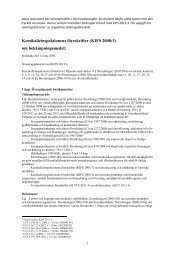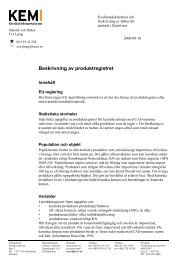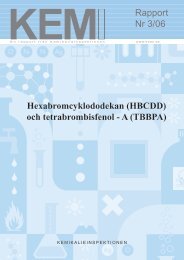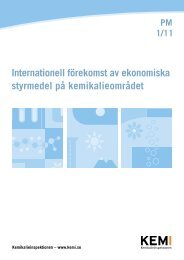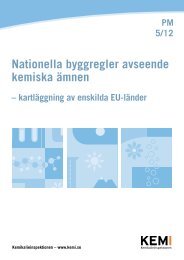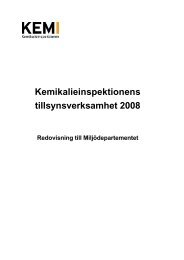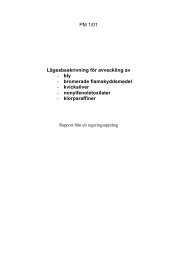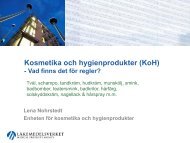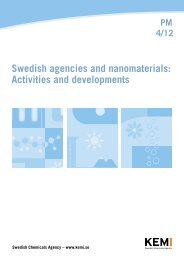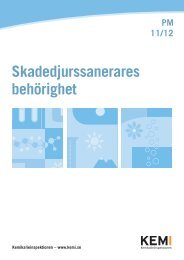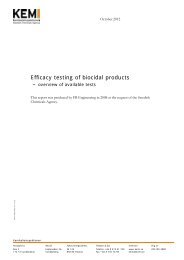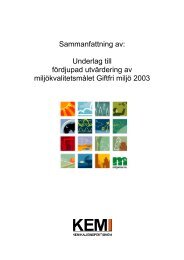Towards a Non-Toxic Environment in South-East Asia
Towards a Non-Toxic Environment in South-East Asia
Towards a Non-Toxic Environment in South-East Asia
You also want an ePaper? Increase the reach of your titles
YUMPU automatically turns print PDFs into web optimized ePapers that Google loves.
The ChallengeGovernments need to take controlChemicals are part of everyone’s life. They are essential forvirtually every sector <strong>in</strong> today’s society. Besides the many benefits,there are also deep concerns about threats posed to global healthand the environment.Chemicals production, use and disposal cont<strong>in</strong>ue to expandworldwide. Assessments and forecasts, project<strong>in</strong>g trends to 2050,predict that global chemical sales will grow about 3 per cent peryear to 2050. Chemical manufactur<strong>in</strong>g and process<strong>in</strong>g activities,once largely located <strong>in</strong> the highly <strong>in</strong>dustrialised countries, arenow steadily expand<strong>in</strong>g <strong>in</strong>to develop<strong>in</strong>g countries and countrieswith economies <strong>in</strong> transition.Trace levels of chemicals, such as DDT, PCBs, mercury, lead and othertox<strong>in</strong>s have been found <strong>in</strong> people and animals all over the world.But very few people are aware of how this can affect their health.In 2011, researchers from the World Health Organization (WHO)used available estimates for certa<strong>in</strong> toxic chemicals to calculatethe global burden of disease. They estimated that <strong>in</strong> 2004, at least2.3 million deaths and 34.1 million disability-adjusted life years4
(DALYs), which address a blend of death and disease impact canbe attributed to handl<strong>in</strong>g of, and exposure to, selected <strong>in</strong>dustrialchemicals. Of special note was the f<strong>in</strong>d<strong>in</strong>g that children under age15 years were a highly susceptible group.Only when a sudden disaster happens, we come to know aboutit. We recall Bhopal <strong>in</strong> 1984, when a chemical leakage led tomore than 5,000 dead and hundreds of thousands poisoned. Theconsequences are still affect<strong>in</strong>g the people and the environmentof Bhopal.Of the tens of thousands of chemicals on the market, only a fractionhas been thoroughly evaluated to fully determ<strong>in</strong>e their effectson human health and the environment. Even if some progress isbe<strong>in</strong>g made to fill some of the gaps about health and environmenteffects, this data rema<strong>in</strong>s limited to <strong>in</strong>dividual chemicals. Real-lifeexposures are rarely limited to a s<strong>in</strong>gle chemical and very little<strong>in</strong>formation is available on the health and environmental effectsof chemical mixtures.With rapid <strong>in</strong>dustrialisation, countries <strong>in</strong> <strong>South</strong> <strong>East</strong> <strong>Asia</strong> facemany challenges <strong>in</strong> the area of chemicals management. The<strong>in</strong>tensive, and often <strong>in</strong>sufficiently controlled, use of pesticides <strong>in</strong>the large agriculture sector is part of the issue. The most readilyavailable pesticides <strong>in</strong> <strong>South</strong>-<strong>East</strong> <strong>Asia</strong> are often the most toxicand broad-spectrum products. The effects on public health andthe environment can be devastat<strong>in</strong>g. Institutions, legislation,enforcement and general awareness need to be enhanced.Besides the obvious negative effect on health and environment,the lack of control on pesticide use and result<strong>in</strong>g residues has alsoaffected trade. Due to tough restrictions on the use of chemicals <strong>in</strong>the European Union and the USA, entire shipments of vegetablesand seafood with unacceptable high level of chemical residueshave been sent back to the country of orig<strong>in</strong>. The economic lossesare considerable to farmers, <strong>in</strong>dustry and governments – and thepeople of the affected countries.Governments need to take action to control and regulate thesechemicals more effectively. “<strong>Towards</strong> a <strong>Non</strong>-<strong>Toxic</strong> <strong>Environment</strong><strong>in</strong> <strong>South</strong>-<strong>East</strong> <strong>Asia</strong>” provides assistance <strong>in</strong> tak<strong>in</strong>g on the challenge.5
The ProgrammeSeek<strong>in</strong>g a holistic approachThe major challenge is to deal with the fact that responsibilitiesand activities for chemical management are spread amongmany m<strong>in</strong>istries and <strong>in</strong>stitutions. Instead of deal<strong>in</strong>g with onechemical substance at a time, governments need to take action <strong>in</strong>a concerted manner. Changes <strong>in</strong> the <strong>in</strong>stitutional and regulatoryframework and policy reform must go hand <strong>in</strong> hand.The programme works with a holistic, <strong>in</strong>clusive approach try<strong>in</strong>gto seek synergies from efforts at different levels. At the grassroot level, rural communities are empowered to tackle pesticiderelatedproblems from a risk-reduction perspective. Use of themost hazardous pesticides must be elim<strong>in</strong>ated. Overall use ofchemicals must be reduced <strong>in</strong> favour of susta<strong>in</strong>able alternatives,such as Integrated Pest Management. Tra<strong>in</strong><strong>in</strong>g of farmers forsusta<strong>in</strong>able <strong>in</strong>tensification of crop production and educationof farmers and school children <strong>in</strong> pesticide risk reduction areimportant parts of this work.7
But empower<strong>in</strong>g communities at the grass root level is not enough.Simultaneously, the programme helps enhance policy reform andregulatory control at national and regional levels. A particularstrength of the programme is its enhancement of direct feedbackfrom community based monitor<strong>in</strong>g and <strong>in</strong>formation gather<strong>in</strong>g<strong>in</strong>to policy formulation.Work<strong>in</strong>g both with governments at different levels and with civilsociety organisations (CSOs) ensures a broad approach towardschang<strong>in</strong>g behaviour and policies at all levels of society.By us<strong>in</strong>g similar l<strong>in</strong>kages, a susta<strong>in</strong>able system to control the useof chemicals can be built up. Informed and empowered farmersand local community leaders enhance change from the bottom-8
up, while strengthen<strong>in</strong>g of regulatory control simultaneouslyaddresses the issues from the top-down.It is our vision that a successful and broad regional programmeon chemical safety can most effectively be developed throughgradual expansion from a limited <strong>in</strong>itial focus. The programmestarted with a focus on the urgent and widespread problemsrelated to pesticide use, with an emphasis on elim<strong>in</strong>ation ofhighly hazardous and persistent pesticides. Key elements ofthe approach <strong>in</strong>clude broad awareness rais<strong>in</strong>g, strengthen<strong>in</strong>gof regulatory control and promotion of <strong>in</strong>tegrated pestmanagement. In parallel, the experiences ga<strong>in</strong>ed from the workon pesticides are be<strong>in</strong>g used to build up a general chemicalsmanagement capacity.9
Associated organisationFAO Regional Office for <strong>Asia</strong> and the PacificThe FAO <strong>Asia</strong> Regional Integrated Pest Management/PesticideRisk Reduction Programme supports governments and NGOs <strong>in</strong>capacity build<strong>in</strong>g for a coord<strong>in</strong>ated approach to applied research,extension and farmer education activities. The objective is topromote and support the development and application of IPM<strong>in</strong> smallholder crop production throughout the <strong>Asia</strong> region. Theprogramme provides advice, organises tra<strong>in</strong><strong>in</strong>g of tra<strong>in</strong>ers andarranges for exchange of expertise. The programme funds fieldactivities as well as provides advice to national governments forbetter policies <strong>in</strong> the field of farmer education, crop protection,good agricultural practices and rural development.Regional IPM/Pesticide Risk Reduction ProgrammeFAO Regional Office for <strong>Asia</strong> and the Pacific,Bangkok, Thailandwww.fao.org/world/regional/rap/ & www.vegetableipmasia.org11
Associated organisationFAO Headquarters, Pesticides Risk Reduction GroupThe FAO Risk Reduction Group provides guidance to thedevelopment of regulatory frameworks for the control of pesticides.The group works primarily at <strong>in</strong>ternational and governmentlevel. Under this programme, it has provided assistance to LaoPDR, Viet Nam and Cambodia <strong>in</strong> their processes to improvepesticide legislation. Further it assists with capacity build<strong>in</strong>g forthe enforcement of pesticide legislation, notably <strong>in</strong> the areas oflicens<strong>in</strong>g and <strong>in</strong>spection of pesticide retailers.Pesticide Risk Reduction ProgrammePlant Production and Protection DivisionFAO Headquarters,Rome, Italywww.fao.org/agriculture/crops/core-themes/theme/pests/en/12
Associated organisationPesticide Action Network <strong>Asia</strong> and the PacificPesticide Action Network <strong>Asia</strong> and the Pacific (PAN AP) is oneof the regional coord<strong>in</strong>at<strong>in</strong>g centres of PAN. This <strong>in</strong>ternationalcoalition of citizen’s groups and <strong>in</strong>dividuals opposes the misuseof pesticides and supports reliance on safe, susta<strong>in</strong>able pestcontrol methods. PAN has evolved a strong <strong>Asia</strong>n perspective,l<strong>in</strong>ked to more than 150 groups, and works consistently withsome 50 groups <strong>in</strong> 18 countries <strong>in</strong> the <strong>Asia</strong> Pacific region.PAN AP’s Community based Pesticide Action Monitor<strong>in</strong>g(CPAM) project has evolved over a 10-year period and hasbecome a comprehensive programme for awareness rais<strong>in</strong>g andempowerment of local communities. It simultaneously deliversvaluable documentation for advocacy and network<strong>in</strong>g at thenational and <strong>in</strong>ternational level. PAN AP provides <strong>in</strong>formation,analysis and campaign materials for network partners. Theorganisation is actively <strong>in</strong>volved <strong>in</strong> <strong>in</strong>ternational <strong>in</strong>itiatives likethe Rotterdam and Stockholm conventions, the FAO Code ofConduct on the Distribution and Use of Pesticides and the policyframework SAICM. The empowerment of women is a consciouseffort <strong>in</strong> all PAN AP’s work.Pesticide Action Network <strong>Asia</strong> and the PacificPenang, Malaysiawww.panap.net13
Associated organisationThe Field AllianceThe Field Alliance (TFA) derives from the FAO Regional IPMProgramme, which played a prom<strong>in</strong>ent role <strong>in</strong> capacity build<strong>in</strong>gfor susta<strong>in</strong>able agriculture <strong>in</strong> <strong>Asia</strong>. What began as an IntegratedPest Management (IPM) project became an umbrella forfarmer-led experimentation, tra<strong>in</strong><strong>in</strong>g, organis<strong>in</strong>g and advocacy<strong>in</strong> a range of issues on community health, rural education,and farmers’ rights. The vision, methods and expertise thatdrove the Regional IPM Programme are now the basis for an<strong>in</strong>dependent foundation dedicated to the empowerment of <strong>Asia</strong>nfarmers – The Field Alliance. One of the allied organisations,the Thai Education Foundation, has played a lead<strong>in</strong>g role <strong>in</strong> thedevelopment of environmental education programmes for schoolchildren based on the ‘farmer field school’ approach. Follow<strong>in</strong>gthe pilot activities <strong>in</strong> a number of Thai primary schools, similarprogrammes are currently implemented <strong>in</strong> Cambodia, Lao PDR,Philipp<strong>in</strong>es and Viet Nam.The Field AllianceBangkok, Thailandwww.thefieldalliance.org14
Notes15



